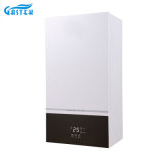What is the process of a gas boiler?
2024-07-08
The process of a gas boiler involves several key steps, from activation to heat distribution. Here is a detailed explanation of each step in the process:

1. Activation:
- The thermostat detects a drop in room temperature below the preset level and sends a signal to the boiler to start.
2. Gas Supply:
- The gas valve opens, allowing natural gas to flow to the burner.
3. Ignition:
- The boiler’s ignition system (either a pilot light or an electronic igniter) ignites the gas. This creates a flame in the burner.
4. Heating the Heat Exchanger:
- The burner heats the heat exchanger, which is a series of metal coils or fins that transfer heat from the burner to the water.
5. Water Circulation:
- Cold water from the heating system enters the boiler and passes through the heat exchanger. The heat from the burner transfers to the water, heating it up.
6. Heat Distribution:
- The heated water is then circulated through the heating system by a pump. This water flows through radiators, underfloor heating pipes, or a hot water tank.
7. Exhaust Gas Removal:
- The combustion process produces exhaust gases, including carbon dioxide and water vapor. These gases are expelled outside through a flue.
8. Temperature Regulation:
- The thermostat continuously monitors the room temperature. Once the desired temperature is reached, it signals the boiler to shut off the gas supply and turn off the burner.
9. Standby Mode:
- The boiler goes into standby mode, ready to start the process again when the thermostat detects a drop in temperature.
### Additional Safety and Efficiency Features
- Pressure Relief Valve:
- This valve releases water if the pressure inside the boiler gets too high, preventing potential damage.
- Expansion Tank:
- The expansion tank accommodates the expansion and contraction of water as it heats and cools, maintaining consistent pressure in the system.
- Condensing Boilers:
- In modern condensing boilers, additional heat is captured from the exhaust gases, making the boiler more efficient. This process involves cooling the exhaust gases to condense the water vapor, releasing latent heat that is then used to heat the water further.
### Summary
1. Thermostat activates the boiler.
2. Gas valve opens.
3. Ignition system ignites the gas.
4. Burner heats the heat exchanger.
5. Cold water circulates through the heat exchanger and gets heated.
6. Heated water is distributed through the heating system.
7. Exhaust gases are expelled through the flue.
8. Thermostat regulates the temperature, turning the boiler on and off as needed.
9. Boiler remains in standby mode until the next heating cycle.
This step-by-step process ensures that a gas boiler efficiently heats a home while maintaining safety and consistent operation.


